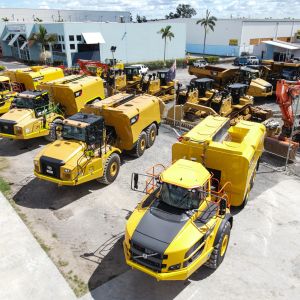The durability of your machine’s undercarriage components is affected by three important factors: ground conditions, how the machine is operated and the correct machine settings. By regularly inspecting your undercarriage, you can identify any minor problems before they turn into expensive costly issues.
While you have only limited control what conditions your machine operates in, you can minimise undercarriage wear by following the below tips.
Minimise undercarriage ‘packing’
Excessive build up of dirt, mud, dust and other material in your machine’s undercarriage (known as packing) can increase track tension causing a significant increase in the wear of idlers, links and sprockets. Abrasion wears out even steel materials, and unnecessary dirt exposure to seals and joints can lead to leaks and premature failure.
In addition to increased wear of your undercarriage, machine efficiency and fuel consumption will be negatively affected by a ‘tight track’.
Regularly clean your undercarriage components to remove any unwanted debris.
Regularly check track tension
As the ground conditions in which the earthmoving machine operates in changes (i.e. starting work at a new job site or changes in weather), the amount of undercarriage ‘packing’ will change, therefore the track tension will need to be altered to suit the new environment. When starting out on a new job site, it’s recommended to run your machine for an hour and then make the necessary changes to your track tension if required.
Consult your machine’s owner’s manual for the correct track adjuster procedure.
Machine operation
- Speed and turning – An operator plays an important role in determining the expected life of a machine’s undercarriage. To reduce the stress on undercarriage components, sharp turns and counter rotations should be minimised and performed at a low speed. An undercarriage inspection can identify if the machine is being operated correctly or not.
- Machine orientation – When your machine is operated in side-hill applications, undercarriage wear will be accelerated as a result of the track links working constantly against the roller flanges. To minimise undercarriage wear in side-hill applications, it’s recommended to operate the machine in both downhill and uphill directions evenly wherever possible.
Other tips
- Avoid point load situations
- Choose grouser plates with appropriate width for the job. Wider track plates gives lower ground pressure in wet conditions, but also means greater forces on the undercarriage in hard surface applications.
- Identify quality parts i.e. For grouser plates, measure bar height & check grouser weight – the heavier the grouser plate usually equates to a better grade of steel.
- Replace track bolts and nuts when changing link assemblies – avoid rounded heads & issues with pre-worn thread – does up nice and tight.
- Remove paint from both chain and plate contact surfaces, because when it rubs off during use, the bolt tension reduces. This will make the plates come loose and possibly elongate holes in both the link and plate.
- Fit plates to correct torque – best done on a track bench.
- Rollers – must have sufficient guide height to keep track straight. One worn roller will start decreasing life of other rollers and idlers




